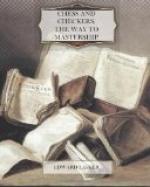Diagram 66.
(16) ... P-e4
(17) Pxe4 Ktxe4
(18) Q-c2
Now that the Queen has left the d-file, unpinning the Knight, something must be done for the Knight e4 who is twice attacked and only once protected. Two moves come into consideration. One is P-f5 which maintains the Knight in the dominating center-position, as White cannot take him without opening the f-file for Black’s Rook and losing the Pawn h2 who needs the protection of the Knight f3. The other is Ktxd2, winning the Pawn h2 right away no matter whether White retakes with the Bishop or with the Knight. Which of the two moves is the better is difficult to say and is more or less a matter of temperament. A player who prefers a slow and sure advance will choose P-f5. A player who likes a faster pace will start the hand-to-hand fight without delay by Ktxd2. It is the latter move on which Black decides.
(18) ... Ktxd2
White now faces the dilemma whether to recapture with the Bishop or with the Knight. If he takes with the Bishop Black exchanges on f3, breaking up White’s chain of Pawns, and he regains his Pawn by Bxh2. If he takes with the Knight, Black also wins the Pawn h2, but the other Pawns in front of the King remain intact. The drawback to the latter continuation is, however, that White’s development is delayed for another two moves, as the Queen’s Bishop is shut in. For this reason White decides on Bxd2, probably also hoping that he will be compensated for the broken Pawn position by an attack in the g- or h-file which Black’s maneuver opens.
+---------------------------------------+ 8 | | | | #R | | #R | #K | | |---------------------------------------| 7 | | #B | #Q | | | #P | #P | | |---------------------------------------| 6 | #P | | | #B | | | | #P | |---------------------------------------| 5 | | #P | | | | | | | |---------------------------------------| 4 | | | | | | | | | |---------------------------------------| 3 | | ^P | ^P | | | ^Kt| | | |---------------------------------------| 2 | | ^P | ^Q | #Kt| | ^P | ^P | ^P | |---------------------------------------| 1 | ^R | | ^B | | ^R | | ^K | | +---------------------------------------+ a b c d e f g h
Diagram 67.
(19) Bxd2 Bxf3
The fact that Black has to exchange his well placed Queen’s Bishop in order to win the Pawn h2 was very likely another reason which induced White to retake with the Bishop.




